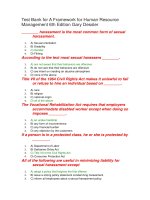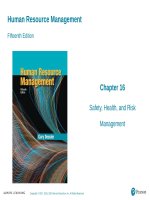Human resource management 15e by gary dessler 2017 chapter 04
Bạn đang xem bản rút gọn của tài liệu. Xem và tải ngay bản đầy đủ của tài liệu tại đây (1.02 MB, 56 trang )
Human Resource Management
Fifteenth Edition
Chapter 4
Job Analysis and the Talent
Management Process
Copyright © 2017, 2015, 2013 Pearson Education, Inc. All Rights Reserved
Learning Objectives (1 of 3)
4-1. Define talent management and explain why it is important.
4-2. Discuss the process of job analysis, including why it is important.
Copyright © 2017, 2015, 2013 Pearson Education, Inc. All Rights Reserved
Learning Objectives (2 of 3)
4-3. Explain how to use at least three methods of collecting job analysis information,
including interviews, questionnaires, and observation.
4-4. Explain how you would write a job description.
4-5. Explain how to write a job specification.
Copyright © 2017, 2015, 2013 Pearson Education, Inc. All Rights Reserved
Learning Objectives (3 of 3)
4-6. List some human traits and behaviors you would want an employee to bring to a job
if employee engagement is important to doing the job well.
4-7. Explain competency-based job analysis, including what it means and how it’s done in
practice.
Copyright © 2017, 2015, 2013 Pearson Education, Inc. All Rights Reserved
I.
Define talent management and explain why it is
important.
Copyright © 2017, 2015, 2013 Pearson Education, Inc. All Rights Reserved
The Talent Management Process
•
Decide what positions to fill
•
Build a pool of job candidates
•
Obtain application forms
•
Use selection tools
•
Decide to whom to make an offer
•
Orient, train, and develop employees
•
Appraise employees
•
Compensate employees to maintain their motivation
Copyright © 2017, 2015, 2013 Pearson Education, Inc. All Rights Reserved
Improving Performance Through HRIS: Talent Management
Software
Talent Management Suite
Let’s take a look..
Copyright © 2017, 2015, 2013 Pearson Education, Inc. All Rights Reserved
II.
Discuss the process of job analysis, including why it is
important.
Copyright © 2017, 2015, 2013 Pearson Education, Inc. All Rights Reserved
The Basics of Job Analysis
•
Work activities
•
Human behaviors
•
Machines, tools, equipment, and work aids
•
Performance standards
•
Job context
•
Human requirements
Copyright © 2017, 2015, 2013 Pearson Education, Inc. All Rights Reserved
What Is Job Analysis?
•
Job Analysis – is the procedure through which you determine the duties and skill
requirements of a job and the kind of person who should be hired for it.
Copyright © 2017, 2015, 2013 Pearson Education, Inc. All Rights Reserved
Uses of Job Analysis Information
•
Recruitment and
selection
•
EEO compliance
•
Performance appraisal
•
Compensation
•
Training
FIGURE 4-2 Uses of Job Analysis Information
Copyright © 2017, 2015, 2013 Pearson Education, Inc. All Rights Reserved
Conducting a Job Analysis
1.
How will information be used?
2.
Background information
3.
Representative positions
4.
Collect and analyze data
5.
Verify
6.
Job description and specification
Copyright © 2017, 2015, 2013 Pearson Education, Inc. All Rights Reserved
Processes involved in Job Analysis
•
Workflow Analysis
FIGURE 4-3 Process Chart for Analyzing a Job’s
Workflow
Source: Henderson, Richard I., Compensation Management in a
Knowledge -Based World, 9th Ed., © 2003, p.137. Reprinted and
Electronically reproduced by permission of Pearson Education, Inc.,
Upper Saddle River, New Jersey.
Copyright © 2017, 2015, 2013 Pearson Education, Inc. All Rights Reserved
Other Processes involved in Job Analysis
•
Business Process Reengineering
–
–
–
–
Job Redesign
Job Enlargement
Job Rotation
Job Enrichment
Copyright © 2017, 2015, 2013 Pearson Education, Inc. All Rights Reserved
Improving Performance: HR as a Profit Center
Boosting Productivity Through Work Redesign
Let’s talk about it…
Copyright © 2017, 2015, 2013 Pearson Education, Inc. All Rights Reserved
III.
Explain how to use at least three methods of collecting
job analysis information, including interviews,
questionnaires, and observation.
Copyright © 2017, 2015, 2013 Pearson Education, Inc. All Rights Reserved
Methods for Collecting Job Analysis Information
1.
Interviews
2.
Quantitative “position analysis”
questionnaire
3.
Additional Things to keep in mind
Copyright © 2017, 2015, 2013 Pearson Education, Inc. All Rights Reserved
The Interview
1.
Typical Questions
2.
Structure Interviews
3.
Pros and Cons
4.
Interviewing Guidelines
Copyright © 2017, 2015, 2013 Pearson Education, Inc. All Rights Reserved
Questionnaires
Copyright © 2017, 2015, 2013 Pearson Education, Inc. All Rights Reserved
Observations
Copyright © 2017, 2015, 2013 Pearson Education, Inc. All Rights Reserved
Participant Diary /Logs
Copyright © 2017, 2015, 2013 Pearson Education, Inc. All Rights Reserved
Quantitative Job Analysis Techniques
1.
Position Analysis Questionnaire
2.
Department of Labor (DOL) Procedure
Copyright © 2017, 2015, 2013 Pearson Education, Inc. All Rights Reserved
Electronic Job Analysis Methods
Copyright © 2017, 2015, 2013 Pearson Education, Inc. All Rights Reserved
IV.
Explain how you would write a job description.
Copyright © 2017, 2015, 2013 Pearson Education, Inc. All Rights Reserved
Writing Job Descriptions (1 of 2)
Copyright © 2017, 2015, 2013 Pearson Education, Inc. All Rights Reserved









